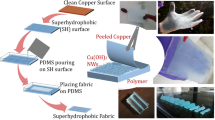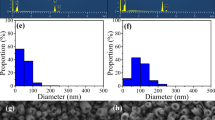Abstract
This work demonstrates a bottom-up model of fabricating a honeycomb-inspired interface consisting of micro- and nanostructures for improving poly(dimethylsiloxane) (PDMS) hydrophobicity. TiO2 nanorod arrays and microsized voids were fabricated by a two-step hydrothermal reaction method. First, rutile TiO2 nanorod arrays were hydrothermally fabricated on the fluorine-doped SnO2 conductive substrates substrate. Second, microsized TiO2 voids were synthesized through HCl hydrothermal etching to obtain a honeycomb-inspired interface with tunable size. The size of the etched voids increased from 0.22 ± 0.06 to 8.0 ± 2.8 μm. The interfaces were then transferred on the PDMS surface to improve hydrophobic property. The contact angles of the corresponding positive PDMS replicas reached 140° after etching with the TiO2 nanorod arrays for 10 h. The size of mastoid structures on the PDMS surfaces was 7.5 μm, which is similar to the size of microstructures on the lotus leaf surface. The fabricated PDMS surface with tunable hydrophobicity properties can be used in the microfluidic channels in the future.






Similar content being viewed by others
References
Sun TL, Feng L, Gao XF, Jiang L (2005) Bioinspired surfaces with special wettability. Acc Chem Res 38:644–652
Jin MH, Feng XJ, Xi JM, Zhai J, Cho K, Feng L, Jiang L (2005) Super-hydrophobic PDMS surface with ultra-low adhesive force. Macromol Rapid Commun 26:1805–1809
Sun MH, Luo CX, Xu LP, Ji H, Ouyang Q, Yu DP, Chen Y (2005) Artificial lotus leaf by nanocasting. Langmuir 21:8978–8981
Su B, Li M, Lu QH (2010) Toward understanding whether superhydrophobic surfaces can really decrease fluidic friction drag. Langmuir 26:6048–6052
Feng L, Li S, Li Y, Li H, Zhang L, Zhai J, Song Y, Liu B, Jiang L, Zhu D (2002) Super-hydrophobic surfaces: from natural to artificial. Adv Mater 14:1857–1860
Chou SY, Yu CC, Yen YT, Lin KT, Chen HL, Su WF (2015) Romantic story or raman scattering? Rose petals as ecofriendly, low-cost substrates for ultrasensitive surface-enhanced raman scattering. Anal Chem 87:6017–6024
Cheng QF, Jiang L, Tang ZY (2014) Bioinspired layered materials with superior mechanical performance. Acc Chem Res 47:1256–1266
Hou X, Guo W, Jiang L (2011) Biomimetic smart nanopores and nanochannels. Chem Soc Rev 40:2385–2401
Bai H, Ju J, Zheng YM, Jiang L (2012) Functional fibers with unique wettability inspired by spider silks. Adv Mater 24:2786–2791
Jiang L, Zhao Y, Zhai J (2004) A lotus-leaf-like superhydrophobic surface: a porous microsphere/nanofiber composite film prepared by electrohydrodynamics. Angew Chem Int Ed 116:4438–4441
Liu KS, Cao MY, Fujishima A, Jiang L (2014) Bio-inspired titanium dioxide materials with special wettability and their applications. Chem Rev 114:10044–10094
Zhang NG, Deng YL, Tai QD, Cheng BR, Zhao LB, Shen QL, He RX, Hong LY, Liu W, Guo SS, Liu K, Tseng HR, Xiong B, Zhao XZ (2012) Electrospun TiO2 nanofiber-based cell capture assay for detecting circulating tumor cells from colorectal and gastric cancer patients. Adv Mater 24:2756–2760
He RX, Zhao LB, Liu YM, Zhang NG, Cheng BL, He ZB, Cai B, Li SS, Liu W, Guo SS, Chen Y, Xiong B, Zhao XZ (2013) Biocompatible TiO2 nanoparticle-based cell immunoassay for circulating tumor cells capture and identification from cancer patients. Biomed Microdevices 15:617–626
Huang QQ, Chen BL, He RX, He ZB, Cai B, Xu JH, Qian WY, Chan HL, Liu W, Guo SS, Zhao XZ, Yuan JK (2014) Capture and release of cancer cells based on sacrificeable transparent MnO2 nanospheres thin film. Adv Healthc Mater 3:1420–1425
Xiao JR, He WQ, Zhang ZT, Zhang WY, Cao YP, He RX, Chen Y (2015) PDMS micropillar-based microchip for efficient cancer cell capture. RSC Adv 5:52161–52166
Wang S, Liu K, Yao X, Jiang L (2015) Bioinspired surfaces with superwettability: new insight on theory, design, and applications. Chem Rev 115:8230–8293
Law JBK, Ng AMH, He AY, Low HY (2014) Bioinspired ultrahigh water pinning nanostructures. Langmuir 30:325–331
Yong J, Chen F, Yang Q, Zhang D, Bian H, Du G, Si J, Meng X, Hou X (2013) Controllable adhesive superhydrophobic surfaces based on PDMS microwell arrays. Langmuir 29:3274–3279
Oh JK, Lu X, Min Y, Cisneros-Zevallos L, Akbulut M (2015) Bacterially antiadhesive optically transparent surfaces inspired from rice leaves. ACS Appl Mater Interfaces 7:19274–19281
Lv M, Zheng D, Ye M, Xiao J, Guo W, Lai Y, Sun L, Lin C, Zuo J (2013) Optimized porous rutile TiO2 nanorod arrays for enhancing the efficiency of dye-sensitized solar cells. Energy Environ Sci 6:1615–1622
Hwang YJ, Hahn C, Liu B, Yang P (2012) Photoelectrochemical properties of TiO2 nanowire arrays: a study of the dependence on length and atomic layer deposition coating. ACS Nano 6:5060–5069
Zhang X, Liu Y, Lee ST, Yang S, Kang Z (2014) Coupling surface plasmon resonance of gold nanoparticles with slow-photon-effect of TiO2 photonic crystals for synergistically enhanced photoelectrochemical water splitting. Energy Environ Sci 7:1409–1419
Liu YM, Zhang ML, Jiang Y, Xia Y, Sun WW, Zhao XZ (2015) General strategy to construct hierarchical TiO2 nanorod arrays coupling with plasmonic resonance for dye-sensitized solar cells. Electrochim Acta 173:483–489
Su B, Gong S, Ma Z, Yap LW, Cheng W (2015) Mimosa-inspired design of a flexible pressure sensor with touch sensitivity. Small 11:1886–1891
Dey R, Raj MK, Bhandaru N, Mukherjee R, Chakraborty S (2014) Tunable hydrodynamic characteristics in microchannels with biomimetic superhydrophobic (lotus leaf replica) walls. Soft Matter 10:3451–3462
Liu B, He Y, Fan Y, Wang X (2006) Fabricating super-hydrophobic lotus-leaf-like surfaces through soft-lithographic imprinting. Macromol Rapid Commun 27:1859–1864
He WQ, Xiao JR, Zhang ZT, Zhang WY, Cao YP, He RX, Chen Y (2015) One-step electroplating 3D template with gradient height to enhance micromixing in microfluidic chips. Microfluid Nanofluid 19:829–836
Liu B, Aydil ES (2009) Growth of oriented single-crystalline rutile TiO2 nanorods on transparent conducting substrates for dye-sensitized solar cells. J Am Chem Soc 131:3985–3990
Guo W, Xu C, Wang X, Wang S, Pan C, Lin C, Wang ZL (2012) Rectangular bunched rutile TiO2 nanorod arrays grown on carbon fiber for dye-sensitized solar cells. J Am Chem Soc 134:4437–4441
Cheng H, Ma J, Zhao Z, Qi L (1995) Hydrothermal preparation of uniform nanosize rutile and anatase particles. Chem Mater 7:663–671
Kumar A, Madaria AR, Zhou C (2010) Growth of aligned single-crystalline rutile TiO2 nanowires on arbitrary substrates and their application in dye-sensitized solar cells. J Phys Chem C 114:7787–7792
Dudem B, Ko YH, Leem JW, Lee SH, Yu JS (2015) Highly transparent and flexible triboelectric nanogenerators with subwavelength-architectured polydimethylsiloxane by a nanoporous anodic aluminum oxide template. ACS Appl Mater Interfaces 7:20520–20529
Fischer KE, Alemán BJ, Tao SL, Daniels RH, Li EM, Bünger MD, Nagaraj G, Singh P, Zettl A, Desai TA (2009) Biomimetic nanowire coatings for next generation adhesive drug delivery systems. Nano Lett 9:716–720
Acknowledgements
This work was financial supported by the National Natural Science Foundation of China (Grant Nos. 81402466, 61404060) and the Natural Science Foundation of Hubei (No. 2015CFB610). The authors also acknowledge the financial support from the Ph.D. research foundation of Jianghan University.
Author information
Authors and Affiliations
Corresponding authors
Ethics declarations
Conflict of interest
The authors declare that they have no conflict of interest.
Additional information
Jingrong Xiao and Minli Zhang have contributed equally to this work.
Electronic supplementary material
Below is the link to the electronic supplementary material.
Rights and permissions
About this article
Cite this article
He, R., Xiao, J., Zhang, M. et al. Artificial honeycomb-inspired TiO2 nanorod arrays with tunable nano/micro interfaces for improving poly(dimethylsiloxane) surface hydrophobicity. J Mater Sci 51, 2935–2941 (2016). https://doi.org/10.1007/s10853-015-9602-z
Received:
Accepted:
Published:
Issue Date:
DOI: https://doi.org/10.1007/s10853-015-9602-z




